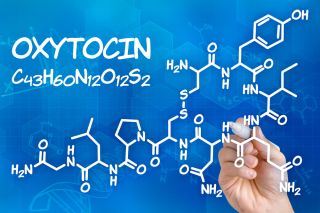Oxytocin
How Oxytocin Affects Our Relationships
Oxytocin pulls the strings of social interactions.
Posted March 30, 2024 Reviewed by Ray Parker
Key points
- Oxytocin is a neurotransmitter that affects both positive and negative relationships.
- Oxytocin influences social interactions, from breastfeeding to romance.
- Oxytocin can also be antisocial, fueling prejudice and anxiety.
- Oxytocin and dopamine work together to promote long-lasting relationships.

By Mac E. Lancaster, BS, and Ran D. Anbar, M.D.
Oxytocin is a neurotransmitter that has been shown to substantially impact a range of social and reproductive activities, such as pair bonding and maternal, collaborative, and sexual behaviors (Love, 2014). It is commonly referred to as the love or cuddle hormone because it promotes prosocial behavior.
Oxytocin promotes both positive and negative social interactions, such as showing affection or prejudice (Love, 2014).
Oxytocin has been demonstrated to increase attention to examining social cues, enhance cognitive processing of social information, and increase attempts to interact socially. Additionally, oxytocin may have a role in changing the level of importance that people attribute to social cues, leading to different associations of appealing and unpleasant values with particular social interactions.
Current research shows that oxytocin may increase empathy, partner bonding, and communication between people. This makes oxytocin vital for sustaining a relationship, as these attributes are important for a long-lasting and healthy relationship, whether it be with friends or significant others (Gravotta, 2013). It also accounts for the physical and emotional attachment we have toward any given person, animal, or object of importance.
However, oxytocin has antisocial properties as well, promoting prejudice and anxiety. Having a deeper understanding of the function of this chemical and how to manage oxytocin levels can lead to better relationships and possibly even reduced stress.
Prosocial Relationships
Oxytocin plays an important part in the physiology and psychology of breastfeeding, as it is stimulated during skin-to-skin contact (Uvnäs Moberg et al., 2020). It triggers milk production and the milk ejection reflex during breastfeeding. (Uvnäs Moberg et al., 2020). During this time, oxytocin plays a role in producing a calm mood and increasing emotions of secure attachment between mother and child (Stuebe et al., 2013).
This chemical has also been found to lessen pain sensitivity, blood pressure, and cortisol levels in both mothers and newborns (Uvnäs Moberg et al., 2020). Further, oxytocin release during breastfeeding helps the mother bond with her infant and has antidepressant and anti-anxiety qualities, which may guard against postpartum depression (Stuebe et al., 2013).
Oxytocin may be very important in the early stages of romantic attachment as well (Schneiderman et al., 2012). In one study, scientists found that couples with higher levels of oxytocin early in their relationship maintained longer relationships and did not experience a decline in their oxytocin levels over six months (Schneiderman et al., 2012).
Independent of sex, length of relationship, and oxytocin levels in the partner, regression analysis demonstrated that oxytocin predicted the likelihood of successful relationships.
Physical touch, exercise, and social interaction are some ways to increase oxytocin levels and strengthen the quality of relationships (Medical Review Board, 2023).
Antisocial Relationships
The experiments above provide evidence that oxytocin promotes positive social interactions; however, it can also cause the reverse, making our labeling of oxytocin much more complex. Having high amounts of oxytocin while under duress will cause antisocial behavior, such as social avoidance, the development of phobias, and possibly even anxiety disorders (Jones et al., 2017; Holder, 2017).
Oxytocin only promotes empathy and positive emotions for an "ingroup” or a familiar group of people. It has been experimentally shown that when outsiders to a group are introduced, oxytocin has an almost opposite effect and can promote prejudice, hatred, and, in some extreme cases, violence (Choi, 2013).
In experiments run in Amsterdam, half a test group was given a spray that contained oxytocin, and the other half was given a placebo. In the numerous tests that followed, participants given oxytocin were more likely to associate foreigners with negative words. Additionally, a higher proportion of them indicated that they would prefer to save a member of their own ingroup over an outsider (Choi, 2013).
The best theory to explain why oxytocin causes this prejudice is to protect ingroups from the unknown. Evolutionarily, prejudice acts as a shortcut to protect from threats by assessing a scenario associated with a foreign entity as dangerous. (Grewal, 2014). However, in today’s collective modern age, oxytocin's propensity to cause prejudice is more likely to be harmful than helpful.
Oxytocin and the Reward System
Oxytocin and dopamine, the reward chemical, work together to affect social behavior and bonding (Geißert et al., 2022). This system plays a key role in rewarding sensations, which is how we assign positive or negative values, reinforcing us to learn certain behaviors (Love, 2014). Oxytocin release alone does not cause pleasure (Geißert et al., 2022); however, it serves a mediating role in naturally rewarding social behaviors (Peris et al., 2017).
Oxytocin release leads to the secretion or inhibition of dopamine, depending on the affected region of the brain (Charlet & Grinevich, 2017). In reward areas, dopamine is stimulated, and associations are built between sensations of pleasure and activities that stimulate oxytocin, like social interaction, resulting in increased attachment (Geißert et al., 2022). Oxytocin release in the motor areas inhibits dopamine, which helps lessen socially irrelevant motor activity (Charlet & Grinevich, 2017).
The synergy between oxytocin and dopamine helps explain why we feel excited when seeing loved ones or spending time with old friends. When oxytocin stimulates dopamine's rewarding properties, euphoric feelings result. This explains why long-term relationships are so satisfying. Regular oxytocin secretion triggers sustainable dopamine release, increasing motivation to maintain the relationship.
Takeaway
Oxytocin plays a huge role in our daily social interactions. It fuels maternal instincts, tells us who brings us the most joy, helps us make friends, and is associated with the development of empathy as well as hatred and prejudice. From friendships to our reproductive system to love itself, oxytocin is a far more influential chemical than its unassuming name: the love or cuddle hormone.
Mac Lancaster obtained his undergraduate degree in cognitive and behavioral neuroscience at UC San Diego.
References
Charlet, A., & Grinevich, V. (2017). Oxytocin mobilizes midbrain dopamine toward sociality. Neuron, 95(2), 235-237, https://doi.org/10.1016/j.neuron.2017.07.002
Choi, C. Q. (2013, August 17). A love-hate relationship?: “feel-good” oxytocin may have a dark side. Scientific American. https://www.scientificamerican.com/article/a-love-hate-relationship/
Geißert, L., Schmidt, N., Henkel, K., Luxem, A., & Hennig, J. (2022). Dopamine and oxytocin and their relevance for attachment: A gene x gene interaction study. Personality and Individual Differences, 196. https://doi.org/10.1016/j.paid.2022.111752
Gravotta, L. (2013, August 17). Be mine forever: Oxytocin may help build long-lasting love. Scientific American. https://www.scientificamerican.com/article/be-mine-forever-oxytocin/
Grewal, D. (2014, January 24). The Evolution of Prejudice. Scientific American. https://www.scientificamerican.com/article/evolution-of-prejudice/
Holder, K. (2017, September 20). Oxytocin Turns Up the Volume of your Social Environment. UC Davis. https://www.ucdavis.edu/news/oxytocin-turns-volume-your-social-environm…
Jones, C., Barrera, I., Brothers, S., Ring, R., & Wahlestedt, C. (2017). Oxytocin and social functioning. Dialogues in Clinical Neuroscience, 19(2), 193–201. https://doi.org/10.31887/DCNS.2017.19.2/cjones
LeWine, H. E. (2023, June 13). Oxytocin: The love hormone. Harvard Health. https://www.health.harvard.edu/mind-and-mood/oxytocin-the-love-hormone
Love, T. M. (2014). Oxytocin, motivation and the role of dopamine. Pharmacology, Biochemistry, and Behavior, 119, 49–60. https://doi.org/10.1016/j.pbb.2013.06.011
Medical Review Board. (2023, March 2). How to increase oxytocin and improve hormonal balance. BodyLogicMD. https://www.bodylogicmd.com/blog/how-to-increase-oxytocin/
Peris, J., MacFadyen, K., Smith, J. A., de Kloet, A. D., Wang, L., & Krause, E. G. (2017). Oxytocin receptors are expressed on dopamine and glutamate neurons in the mouse ventral tegmental area that project to nucleus accumbens and other mesolimbic targets. The Journal of Comparative Neurology, 525(5), 1094–1108. https://doi.org/10.1002/cne.24116
Schneiderman, I., Zagoory-Sharon, O., Leckman, J. F., & Feldman, R. (2012). Oxytocin during the initial stages of romantic attachment: relations to couples' interactive reciprocity. Psychoneuroendocrinology, 37(8), 1277–1285. https://doi.org/10.1016/j.psyneuen.2011.12.021
Stuebe, A. M., Grewen, K., & Meltzer-Brody, S. (2013). Association between maternal mood and oxytocin response to breastfeeding. Journal of Women's Health, 22(4), 352–361. https://doi.org/10.1089/jwh.2012.3768
Sue Carter C. (2018). Oxytocin and human evolution. Current Topics in Behavioral Neurosciences, 35, 291–319. https://doi.org/10.1007/7854_2017_18
Uvnäs Moberg, K., Ekström-Bergström, A., Buckley, S., Massarotti, C., Pajalic, Z., Luegmair, K., Kotlowska, A., Lengler, L., Olza, I., Grylka-Baeschlin, S., Leahy-Warren, P., Hadjigeorgiu, E., Villarmea, S., & Dencker, A. (2020). Maternal plasma levels of oxytocin during breastfeeding-A systematic review. PloS one, 15(8), e0235806. https://doi.org/10.1371/journal.pone.0235806




